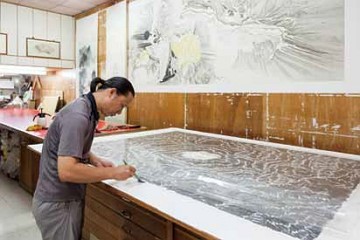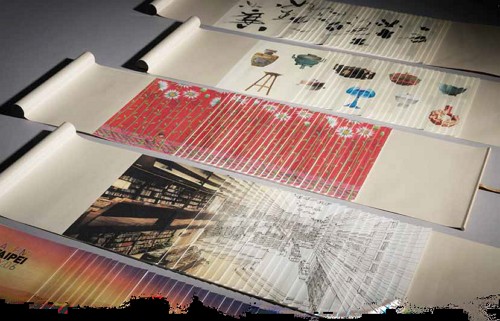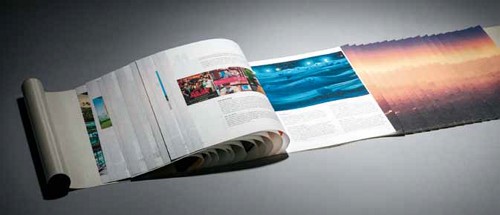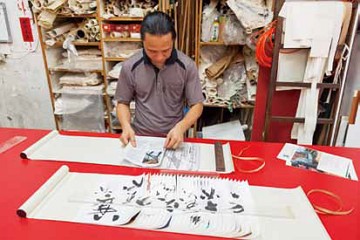Dragon Scale Binding: The Rebirth of an Ancient Bookbinding Technique
In November 2013 Taipei won the bid for the 2016 World Design Capital (WDC), owing in no small part to its masterfully created application book. The book is made use of a rare, ancient form of binding called dragon scale binding (龍鱗裝). To the Chinese, the binding of books is not simply a functional matter of stapling the pages together. Rather, it is considered an art form, called zhuangzheng (裝幀), the history of which is as ancient and multifaceted as the history of Chinese culture itself. In the Shang Dynasty (商朝), 1,700 years before the invention of paper, the first bodies of Chinese writing appeared. These were oracle bones used for divination, written on turtle shells and ox scapulae. Later, bamboo would be used as a medium for the first bound books. Since bamboo is not a flat material, it was cut into long, vertical strips. Each strip contained one column of carved text, and the strips were bound together with string and rolled up. The result was a book that was both sturdy and waterproof. The oldest surviving example dates from the 5th century BC. 105 AD is traditionally cited as the date of the invention of paper. An official named Cai Lun (蔡倫) created a sheet for the court out of a mishmash of materials including morus skin, bast fibers, fishnets, and hemp. Papermaking quickly spread throughout China and Asia, and revolutionized Chinese culture. Along with the widespread use of paper came the need for new binding techniques. The first form of binding for paper books was scroll roller binding. Scrolls developed from the long, vertical silk banners that were hung on walls to display calligraphy in previous times. Paper strips with images and writing could now be pasted onto the fabric in handscrolls, which could be laid flat on a table and read section by section. The oldest printed book in the world, dating to 868 AD., was of this variety. Discovered in the Dunhuang Caves (敦 煌石窟) in Gansu Province (甘肅省), the five-meter scroll was a copy of the Buddhist Diamond Sutra. Over time, the cumbersome rolling and unrolling of scrolls sparked new innovations in binding. The first new style to develop was folded sutra binding (經摺裝), also known as concertina The first instance of the Chinese book breaking away from the scroll format was found in butterfly binding (蝴蝶裝). Butterfly-bound books were made by folding sheets of paper in half. The folded edges could then be stacked together so that the edges formed a spine. The manner in which the pages opened resembled the fluttering of a butterfly’s wings, hence the descriptive name. A variant of this style, called tuipeng binding (推 蓬裝), featured pages that turned vertically as opposed to horizontally. Due to their resilience and convenience of use, by the Song Dynasty (宋朝) (960~1279), butterfly books were the most common variety. The final phase in the development of Chinese book binding, called stitched thread binding (線裝) reached maturity and became the norm in the Ming Dynasty (明 朝) (1368~1644). Improvements in xuan paper (宣紙) - making technology allowed for more detailed, multicolored printing. Sheets of paper were bound with white silk thread and placed within a cover made of stronger paper backed with silk. Oftentimes threaded books were placed within a box made of wood and covered with silk. While stitched thread binding has largely fallen out of use today in favor of the Western codex style, traditional scrolls and concertina binding techniques have survived to modern times. Dragon Scale Binding: A Long-Forgotten Art One curious development in the history of Chinese bookbinding is that of dragon scale binding, a binding method that was unusual in that it was a transitory step between scrolls and threaded binding, and as such it was quite short-lived. The style reached its heyday in the late Tang Dynasty (唐朝), but subsequently fell out of use. Because there are so few surviving examples, dragon scale binding retains a mysterious aura that has perplexed scholars for centuries. Also known as whirlwind binding (旋風裝), dragon scale binding was an early attempt to resolve the issue of the awkwardness of handling lengthy scrolls. A dragon scale-bound book is still a scroll, but contains pages that are pasted in by their edges. The pages were stacked, with the shortest page on top and longest page at the bottom. The book could then be rolled up like a scroll, but pages could be turned in the manner of future binding styles. Dragon-style binding was imperfect because the individual pages had a tendency to roll up on their own when the scroll was unraveled. However, the books were aesthetically stunning, and the textured surface of the pages resembled the skin of the auspicious dragon, giving the binding style its name. Like traditional scrolls, the books exuded an elegant beauty when rolled and tied with string. The most recent surviving dragon scale-bound book is a 1,000-year-old report by Wang Renxu (王仁煦), handcopied by his wife and master calligrapher Wu Cailuan (吳彩鸞). In 2010, a young master from the Fortune Blessing Studio (祐吉齋) in Beijing named Zhang Xiaodong (張曉棟) made the first dragon scale-bound book in a millennium. He later ascended the Western Hills (西山) in the outskirts of Beijing to present a second dragon scale book to his Buddhist master at the Dragon Springs Temple (龍泉寺). To catch a glimpse of a rare dragon bound book and admire the unique craftsmanship of Tang Dynasty artisans, try the National Palace Museum (國立故宮博物 院), where examples are occasionally on display. The key to Taipei’s successful bid for the 2016 WDC was a five-volume application book presented in the dragon-scale style. Designed by Chen Junliang (陳俊良), the five scrolls signify the culmination of Taiwanese ingenuity and meticulousness. The choice of dragon scale binding harks back to a pivotal phase in the evolution of Chinese bookbinding, showcasing to the world the skills and prowess of Chinese artisans of the past and present. In order to execute the ancient style of binding, a skilled professional was required. Chen sought the assistance of Zhuang Jianjun (莊建俊), an expert in not one but three trades: restoration of paintings, traditional bookbinding, and framing. Zhuang has been in the industry for over 30 years, becoming proficient in a number of techniques, many of which are still passed down from master to apprentice and not taught in schools. Zhuang’s studio in Xinyi Road (信義路), called Tai Gu Zhai (太古齋), has been operating for 23 years. The shop does commissioned work for collectors of traditional Chinese art worldwide. Zhuang has trained numerous apprentices over the years, some of whom have gone on to set up their own shops specializing in traditional arts. Replicating an ancient dragon scale book from antiquity was no simple task. “There are no books or websites instructing how to make dragon scale books,” says Zhuang. “Few people beyond academic circles even know about them.” Zhuang’s only references were the examples displayed in the National Palace Museum. “I had to spend hours researching various framing materials and techniques, paying attention to every last detail.” Some modifications had to be made to produce the sleek outcome necessary to bedazzle the WDC judges. Unlike some ancient dragon scale books, the pages of his were equal in size and the edges pasted adjacent to one another. Instead of the traditional rice paper sheets, which have a tendency to roll up individually when the scroll is unraveled, a custom thermal paper was used. With vertical fibers, this type of paper provides a strong yet soft medium. Zhuang pasted the sheets onto three-layer silk scrolls that were laminated with white glue (from his own secret recipe), which contains a number of Chinese herbal ingredients including borneol and frankincense. According to Zhuang, these two special ingredients help increase the durability of the paper and increase its resistance to rotting. The rods around which the scrolls are wound as well as the fasteners that keep the tied strings in place after the scrolls are rolled are made of handsome black jade from Hualian County (花蓮縣) on Taiwan’s east coast. Taipei’s application book for the 2016 WDC was a collaborative effort between some of Taipei’s top designers and artisans, but without Zhuang’s resourcefulness and expertise, the dragon scale binding might never have been executed with the style and precision that were pivotal in securing Taipei’s position as the next World Design Capital. 2016 Word Design Capital Website: http://wdc2016.taipei/en/home3/  A Brief History of Chinese Bookbinding
A Brief History of Chinese Bookbinding binding, in which the scroll was folded accordion-style, and typically held between two blocks of wood. This allowed readers to quickly locate the desired section.
binding, in which the scroll was folded accordion-style, and typically held between two blocks of wood. This allowed readers to quickly locate the desired section. Dragon Scale Binding is Born in Taiwan With the 2016 World Design Capital Application
Dragon Scale Binding is Born in Taiwan With the 2016 World Design Capital Application Once Zhuang pasted the pages to each of the five volumes, their individual cover images, carefully selected by the designers and representative of the contents of each book, took form: treasures from the National Palace Museum, calligraphy by Dong Yangzi (董陽孜), eslite Bookstore’s spatial blueprint, Jimmy Liao’s (幾米) illustrations, and a Taipei cityscape. The finished products were given a home in a finely crafted bamboo box with a black jade slider. When opened, the contents of the box are a veritable treasure to behold.
Once Zhuang pasted the pages to each of the five volumes, their individual cover images, carefully selected by the designers and representative of the contents of each book, took form: treasures from the National Palace Museum, calligraphy by Dong Yangzi (董陽孜), eslite Bookstore’s spatial blueprint, Jimmy Liao’s (幾米) illustrations, and a Taipei cityscape. The finished products were given a home in a finely crafted bamboo box with a black jade slider. When opened, the contents of the box are a veritable treasure to behold.
Taipei 2016 World Design Capital bid video: www.youtube.com/watch?v=QNkVeVi3XQU

![Taiwan.gov.tw [ open a new window]](/images/egov.png)
